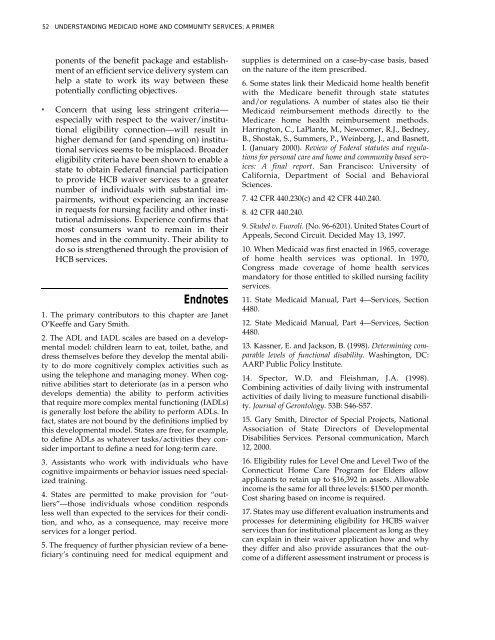Full PDF Version - ASPE - U.S. Department of Health and Human ...
Full PDF Version - ASPE - U.S. Department of Health and Human ...
Full PDF Version - ASPE - U.S. Department of Health and Human ...
- No tags were found...
You also want an ePaper? Increase the reach of your titles
YUMPU automatically turns print PDFs into web optimized ePapers that Google loves.
52 UNDERSTANDING MEDICAID HOME AND COMMUNITY SERVICES: A PRIMERponents <strong>of</strong> the benefit package <strong>and</strong> establishment<strong>of</strong> an efficient service delivery system canhelp a state to work its way between thesepotentially conflicting objectives.• Concern that using less stringent criteria—especially with respect to the waiver/institutionaleligibility connection—will result inhigher dem<strong>and</strong> for (<strong>and</strong> spending on) institutionalservices seems to be misplaced. Broadereligibility criteria have been shown to enable astate to obtain Federal financial participationto provide HCB waiver services to a greaternumber <strong>of</strong> individuals with substantial impairments,without experiencing an increasein requests for nursing facility <strong>and</strong> other institutionaladmissions. Experience confirms thatmost consumers want to remain in theirhomes <strong>and</strong> in the community. Their ability todo so is strengthened through the provision <strong>of</strong>HCB services.Endnotes1. The primary contributors to this chapter are JanetO’Keeffe <strong>and</strong> Gary Smith.2. The ADL <strong>and</strong> IADL scales are based on a developmentalmodel: children learn to eat, toilet, bathe, <strong>and</strong>dress themselves before they develop the mental abilityto do more cognitively complex activities such asusing the telephone <strong>and</strong> managing money. When cognitiveabilities start to deteriorate (as in a person whodevelops dementia) the ability to perform activitiesthat require more complex mental functioning (IADLs)is generally lost before the ability to perform ADLs. Infact, states are not bound by the definitions implied bythis developmental model. States are free, for example,to define ADLs as whatever tasks/activities they considerimportant to define a need for long-term care.3. Assistants who work with individuals who havecognitive impairments or behavior issues need specializedtraining.4. States are permitted to make provision for “outliers”—thoseindividuals whose condition respondsless well than expected to the services for their condition,<strong>and</strong> who, as a consequence, may receive moreservices for a longer period.5. The frequency <strong>of</strong> further physician review <strong>of</strong> a beneficiary’scontinuing need for medical equipment <strong>and</strong>supplies is determined on a case-by-case basis, basedon the nature <strong>of</strong> the item prescribed.6. Some states link their Medicaid home health benefitwith the Medicare benefit through state statutes<strong>and</strong>/or regulations. A number <strong>of</strong> states also tie theirMedicaid reimbursement methods directly to theMedicare home health reimbursement methods.Harrington, C., LaPlante, M., Newcomer, R.J., Bedney,B., Shostak, S., Summers, P., Weinberg, J., <strong>and</strong> Basnett,I. (January 2000). Review <strong>of</strong> Federal statutes <strong>and</strong> regulationsfor personal care <strong>and</strong> home <strong>and</strong> community based services:A final report. San Francisco: University <strong>of</strong>California, <strong>Department</strong> <strong>of</strong> Social <strong>and</strong> BehavioralSciences.7. 42 CFR 440.230(c) <strong>and</strong> 42 CFR 440.240.8. 42 CFR 440.240.9. Skubel v. Fuoroli. (No. 96-6201). United States Court <strong>of</strong>Appeals, Second Circuit. Decided May 13, 1997.10. When Medicaid was first enacted in 1965, coverage<strong>of</strong> home health services was optional. In 1970,Congress made coverage <strong>of</strong> home health servicesm<strong>and</strong>atory for those entitled to skilled nursing facilityservices.11. State Medicaid Manual, Part 4—Services, Section4480.12. State Medicaid Manual, Part 4—Services, Section4480.13. Kassner, E. <strong>and</strong> Jackson, B. (1998). Determining comparablelevels <strong>of</strong> functional disability. Washington, DC:AARP Public Policy Institute.14. Spector, W.D. <strong>and</strong> Fleishman, J.A. (1998).Combining activities <strong>of</strong> daily living with instrumentalactivities <strong>of</strong> daily living to measure functional disability.Journal <strong>of</strong> Gerontology. 53B: S46-S57.15. Gary Smith, Director <strong>of</strong> Special Projects, NationalAssociation <strong>of</strong> State Directors <strong>of</strong> DevelopmentalDisabilities Services. Personal communication, March12, 2000.16. Eligibility rules for Level One <strong>and</strong> Level Two <strong>of</strong> theConnecticut Home Care Program for Elders allowapplicants to retain up to $16,392 in assets. Allowableincome is the same for all three levels: $1500 per month.Cost sharing based on income is required.17. States may use different evaluation instruments <strong>and</strong>processes for determining eligibility for HCBS waiverservices than for institutional placement as long as theycan explain in their waiver application how <strong>and</strong> whythey differ <strong>and</strong> also provide assurances that the outcome<strong>of</strong> a different assessment instrument or process is
















